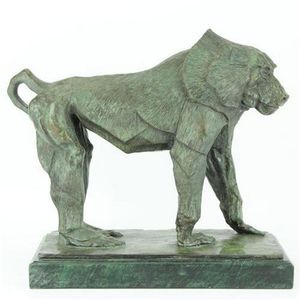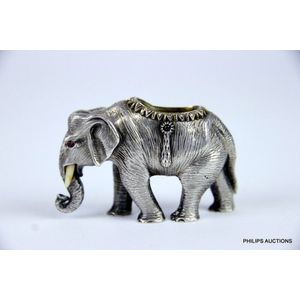Faberge Elephant Match Holder with Gems and Diamonds
A Russian silver and gem set elephant match holder by Faberge, 1896-1908, St Petersburg, 88 zolotniki (916.6) with workmaster's mark, I.P, for Julius Rappoport, and Faberge in Cyrillic, set with eighteen single cut diamonds to the caparison and four cabochon rubies, with ivory tusks and a well for matches, hallmarked to well. Provenance: Private collection Melbourne, acquired at auction in London 1980s for 16,000 pounds, height 4.5 cm width 7 cm
You must be a subscriber, and be logged in to view price and dealer details.
Subscribe Now to view actual auction price for this item
When you subscribe, you have the option of setting the currency in which to display prices to $Au, $US, $NZ or Stg.
This item has been sold, and the description, image and price are for reference purposes only.
- Ivory - Ivory is a hard white material that comes from the tusks of elephants, mammoth, walrus and boar, or from the teeth of hippopotamus and whales. The ivory from the African elephant is the most prized source of ivory. Although the mammoth is extinct, tusks are still being unearthed in Russia and offered for sale.
Ivory has been used since the earliest times as a material for sculpture of small items, both in Europe and the east, principally China and Japan.
In Asia ivory has been carved for netsuke, seals, okimono, card cases, fan supports, animals and other figures and even as carved tusks.
In the last 200 years in Europe ivory has been used to carve figures, for elaborate tankards, snuff boxes, cane handles, embroidery and sewing accessories, in jewellery and as inlay on furniture. Its more practical uses include being used for billiard balls, buttons, and a veneers on the top of piano keys.
The use and trade of elephant ivory have become controversial because they have contributed to Due to the decline in elephant populations because of the trade in ivory, the Asian elephant was placed on Appendix One of the Convention on International Trade in Endangered Species (CITES), in 1975, and in January 1990, the African elephant was similarly listed. Under Appendix One, international trade in Asian or African elephant ivory between member countries is forbidden. Unlike trade in elephant tusks, trade in mammoth tusks is legal.
Since the invention of plastics, there have been many attempts to create an artificial ivory
This item has been included into following indexes:
Visually similar items

A bronze figures modelled of two elephants on a timber base. 30 cm high, 77 cm long.
Sold by
in
for
You can display prices in $Au, $US, $NZ or Stg.

A Beswick model of an elephant, repaired tusk
Sold by
in
for
You can display prices in $Au, $US, $NZ or Stg.

Two bronze figures, including bull and seated fruit vendor, 22.5 x 19 cm
Sold by
in
for
You can display prices in $Au, $US, $NZ or Stg.

Bronze figure of a Hamadryas Baboon, after Rembrandt Bugatti mounted on a green marble base. Condition good, some expected oxidation. Length 32 cm
Sold by
in
for
You can display prices in $Au, $US, $NZ or Stg.
